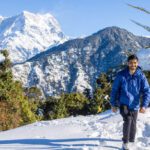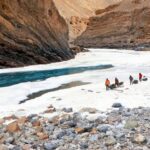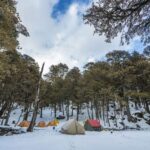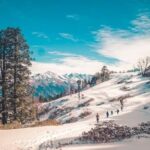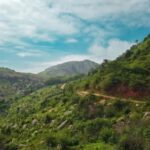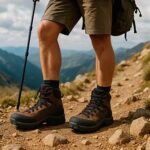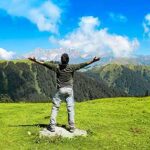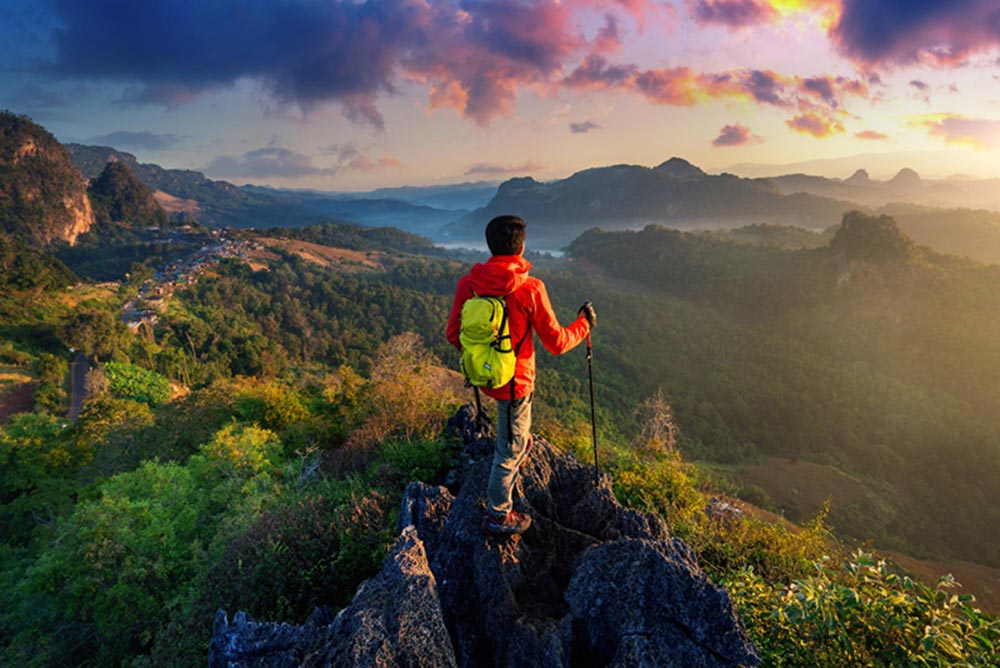
Are hiking and trekking the same thing?
This is a common question, especially among beginners who are just stepping into the world of outdoor adventures.
At first glance, hiking and trekking may seem similar. After all, both involve walking through nature, breathing fresh mountain air, and soaking in scenic views. But when you dig a little deeper, the two are actually quite different in terms of difficulty, duration, planning, and purpose.
So, in this blog, I will discuss both in detail and lay out the actual hiking vs trekking difference.
What Is Hiking?
Hiking is a long walk, usually on well-marked trails or paths, done in a single day or even just a few hours. It’s generally considered easier and more accessible than trekking.
A perfect example of a hike is the Moila Top hike in Chakrata.
This scenic trail winds through dense forests of deodar and pine, leading to a beautiful meadow at the top with panoramic views of the Garhwal Himalayas. The hike is moderately easy, making it suitable for beginners and families. It can comfortably be done within a day and doesn’t require heavy preparation or specialised gear.
During the hike, you can also visit the ancient Buddher Caves, adding a touch of history and mystery to the journey.
Key Features of Hiking :
1. Usually Done on Well-Defined Trails
Hiking trails are often well-marked and easy for you to navigate, making the activity accessible even to beginners.
These trails are maintained by local authorities or forest departments and often include signage, distance markers, and designated resting points. This removes the stress of route-finding and allows you to focus on enjoying nature.
Example: The Triund trek in Himachal Pradesh is a perfect example as it’s a well-laid-out path starting from McLeod Ganj, with clear markings and regular foot traffic.
2. Short Duration
Hikes are typically short in duration, often lasting just a few hours or a single day.
This makes them ideal for weekend plans or even half-day adventures. Unlike trekking, you don’t need to camp overnight or take extended leave.
Example: The George Everest hike in Mussoorie takes about 1 hour and offers panoramic views without consuming an entire day.
3. Requires Basic Fitness
Hiking is suitable for most people with average fitness. You don’t need to be an athlete, just comfortable with walking for a couple of hours and able to manage some mild inclines.
Example: The Benog Tibba hike near Mussoorie is a great beginner-friendly option with gentle slopes and rewarding forest views.
4. Generally Involves Minimal Gear
You don’t need technical gear or heavy backpacks to go hiking. Essentials like good walking shoes, water, light snacks, and weather-appropriate clothing are usually sufficient.
Example: A scenic hike to Deoriatal in Uttarakhand can be completed with basic gear and offers stunning views of Chaukhamba peaks and a tranquil lake.
5. Lower Altitudes Compared to Trekking
Hikes are usually at lower altitudes, making them safer and more comfortable, especially for those not used to high elevations.
Example: The Kheerganga hike in Himachal Pradesh, sitting at an elevation of around 9,222 feet (2810.8656), is considered relatively low compared to high-altitude treks. It’s perfect for casual adventurers and offers a scenic trail through forests and waterfalls, ending at a natural hot spring, all without the usual risks of altitude sickness.
What Is Trekking?
Trekking is a multi-day journey through rugged and often remote landscapes, with more physical demands and preparation involved. Unlike hiking, trekking routes might not always be well-marked, and the terrain can be more challenging.
A perfect example is the Kedarkantha Trek in Uttarakhand. It usually spans 4–5 days, involves snow in the winter, camping at night, and reaches a summit at 12,500 feet. Definitely not a hike.

Another great one? Hampta Pass Trek in Himachal Pradesh. It’s a 5-day trek through valleys, rivers, and glaciers, offering a full trekking experience.
Key Features of Trekking:
1. Covers Multiple Days
Trekking typically spans several days to a few weeks, depending on the route and destination. Trekkers follow a planned itinerary with daily goals covering specific distances. Each day involves several hours of walking, rest stops, and overnight halts.
Example: The Everest Base Camp Trek in Nepal usually takes around 12-14 days, including acclimatisation days.
2. Routes Can Be Steep, Unmarked and Demanding
Unlike hiking trails that are often clearly marked and relatively easy to navigate, trekking paths are often rugged, remote, and involve steep ascents or descents. In some treks, the trails may pass through glacier crossings, riverbeds, and forested regions, requiring basic route-finding skills or the assistance of a local guide.
Example: The Roopkund Trek in India includes steep climbs and crosses difficult terrain like snow patches and narrow ridgelines.
3. Often Involves Camping or Staying in Remote Lodges
Trekking often requires staying in tents, tea houses, or mountain lodges far from urban infrastructure. In some remote treks, carrying your own camping gear is necessary, while in more developed treks like those in Nepal, basic accommodation is available along the trail.
Example: The Kedarkantha Trek in Uttarakhand includes overnight stays in tents pitched in forest clearings, offering a raw mountain experience.
4. Requires Moderate to High Fitness Levels
Due to the sustained physical activity over several days, trekkers need a good level of cardiovascular endurance, leg strength, and stamina. Moreover, proper acclimatisation, hydration, and nutrition are essential to avoid exhaustion or altitude-related illnesses.
Example: The Hampta Pass Trek in Himachal Pradesh involves long trekking days of 6-8 hours, steep climbs, and snow crossings, demanding both fitness and mental stamina.
5. Typically at Higher Altitudes
Many treks take place in mountainous or high-altitude regions, where oxygen levels drop and the risk of Altitude Mountain Sickness (AMS) increases. Trekkers must ascend gradually and often include rest days for acclimatisation.
Example: The Stok Kangri Trek in Ladakh reaches over 6,000 meters (20,180 feet) and requires serious altitude preparation.
6. Immersive Cultural and Natural Experience
Trekking is not just a physical challenge; it also offers a deep cultural and environmental experience. Trekkers often walk through villages, forests, meadows, and rivers, interacting with local communities and witnessing diverse flora and fauna.
Example: The Markha Valley Trek in Ladakh lets trekkers explore Buddhist monasteries, Ladakhi villages, and high-altitude deserts.
7. Usually Requires Permits and Guides (in Some Regions)
Many trekking areas, especially those in protected zones or border regions, require official permits and sometimes even licensed guides for safety and conservation reasons.
Example: The Annapurna Circuit Trek in Nepal requires the TIMS (Trekker’s Information Management System) card and an ACAP (Annapurna Conservation Area Permit).
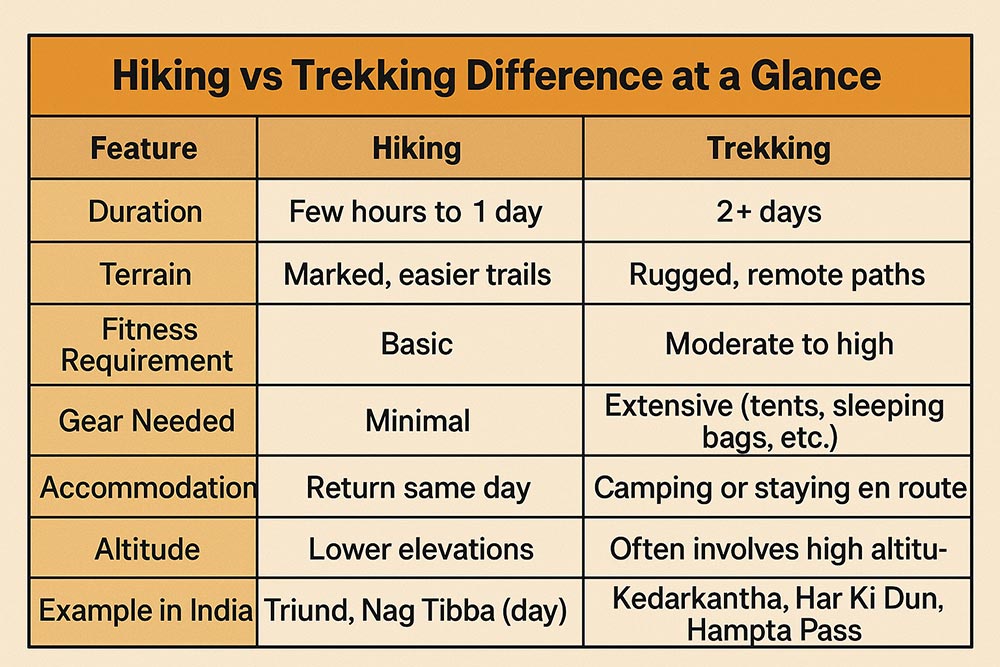
Why the Confusion?
In India, especially in cities like Delhi, Mumbai, and Bangalore, where adventure travel is booming, many travel agencies and Instagram pages use “hiking” and “trekking” interchangeably in their marketing. This has added to the confusion.
People often book a “hike” thinking it’s a casual walk, only to realise it’s a 4-day high-altitude trek! Not fun when you’re carrying a small sling bag and running shoes.
So let’s bust that myth, they are different activities and require different levels of preparation.
Gear & Preparation: Another Big Difference
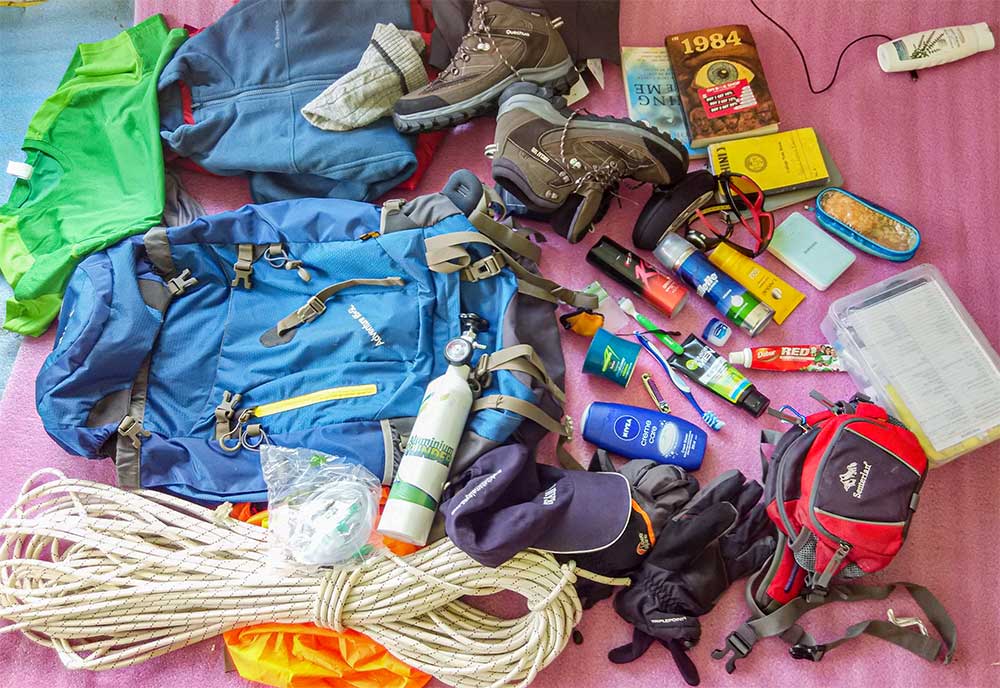
Hiking Gear:
- Lightweight backpack
- Good hiking shoes (not necessarily trekking boots)
- Water bottle
- Snacks
- Sunglasses, hat, and sunscreen
- Optional: trekking pole
Trekking Gear:
- Trekking backpack (40–60L)
- High-ankle trekking boots
- Sleeping bag and tent (or arranged by organisers)
- Layered clothing for altitude
- Rain gear
- Trekking poles
- First aid kit
- Energy bars, hydration packs
As you can see, trekking is a more serious business and demands better planning.
Which One is Right for You?
Not sure whether to hike or trek? Let’s make it easy:
Choose Hiking If:
- You’re just starting out and want to ease into the world of outdoor adventures
- You’ve only got a day or a weekend to spare, but still crave nature.
- You’re planning a trip with kids or elderly family members and need something relaxed.
- You’re in the mood for a light walk with beautiful views, not a multi-day mission
Choose Trekking If:
- You love being deep in nature, away from civilisation
- You’re physically fit and enjoy a challenge.
- You want to camp, stay in mountain villages, and push limits.
- You’re planning a longer trip (5–7 days)
Indian Trekker’s Perspective
Let’s be honest: most of us start with hikes, a short walk to a waterfall in Lonavala, a climb to Savandurga near Bangalore, or a quick visit to Kheerganga.
But slowly, we crave more. That’s when trekking enters the picture, places like the Valley of Flowers, Sandakphu, Brahmatal, or Tarsar Marsar become goals.
Let’s Use the Right Terms
Words matter. When you use the word “hike” to describe a 5-day trek in the Himalayas, it downplays the difficulty and the preparation needed. This can lead to people showing you underprepared, which can be dangerous, especially at higher altitudes.
I experienced this firsthand during the Roopkund Trek, while leading a group of 22 young Chartered Accountants from Nagpur. Despite our company providing detailed guidelines on gear, fitness, and preparation, they showed up in regular sports shoes, thinking it was just a casual multi-day hike.
As we climbed higher and encountered snow, their shoes got completely soaked, offering no insulation or waterproofing. By the second day, many of them were dealing with painful blisters and numb toes, making every step a struggle. It was a harsh wake-up call; they finally realised the critical hiking vs trekking difference, and why proper trekking shoes are not just recommended but absolutely essential for high-altitude treks like Roopkund.
So, let’s educate ourselves and others. If it’s a day walk on a marked trail, call it a hike. If it’s a multi-day journey across wild terrain, it’s a trek.
Both are amazing. Both are life-changing. But they’re not the same.
FAQ about Hiking vs Trekking Difference
What is the difference between hiking and trekking?
Hiking is a short walk, usually on well-marked trails, and can be completed in a few hours or a single day. It’s generally easier and doesn’t require much gear.
Trekking, on the other hand, is a multi-day journey through challenging, remote, and often high-altitude terrain. It involves camping, carrying gear, and a higher level of physical fitness.
Does trek mean hike?
Not exactly. While both involve walking in nature, a trek is not the same as a hike. In India, the words are sometimes used interchangeably, especially in casual conversations or by travel companies. But technically, a hike is shorter and easier, while a trek is more intense and involves multiple days.
Is a trek harder than a hike?
Yes. A trek is almost always harder than a hike as it involves:
Steeper and rougher terrain
Longer durations (2–10+ days)
Higher altitudes (often above 10,000 feet)
Camping or staying in basic shelters
On the other hand, hiking is more relaxed and suitable for beginners or casual adventurers.
Which trek is hardest?
One of the hardest treks in India is the Chadar Trek in Ladakh. It involves walking on a frozen river in sub-zero temperatures (as low as -25°C), over a span of 8–9 days. The risk of ice breaking, extreme cold, and isolation make it a serious challenge. Other tough treks include: Pin Parvati Pass Trek (Himachal Pradesh), Stok Kangri Summit Trek (Ladakh, now restricted but formerly very popular) and Audens Col Trek (Uttarakhand)
Which trek is best in India?
India has many amazing treks, but some of the most popular and beginner-friendly ones include: Kedarkantha Trek (Uttarakhand), Valley of Flowers Trek (Uttarakhand), Hampta Pass Trek (Himachal Pradesh), Sandakphu Trek (West Bengal/Sikkim)
Conclusion
To wrap up, here’s the clear hiking vs trekking difference:
- Hiking is a short, easy walk on marked trails.
- Trekking is a multi-day, physically demanding journey through remote and rugged landscapes.
Now that you know the difference, it’s time to choose your next adventure wisely. Whether you’re hiking to a sunset point or trekking to the heart of the Himalayas, just make sure you’re well-prepared and enjoying every step.

